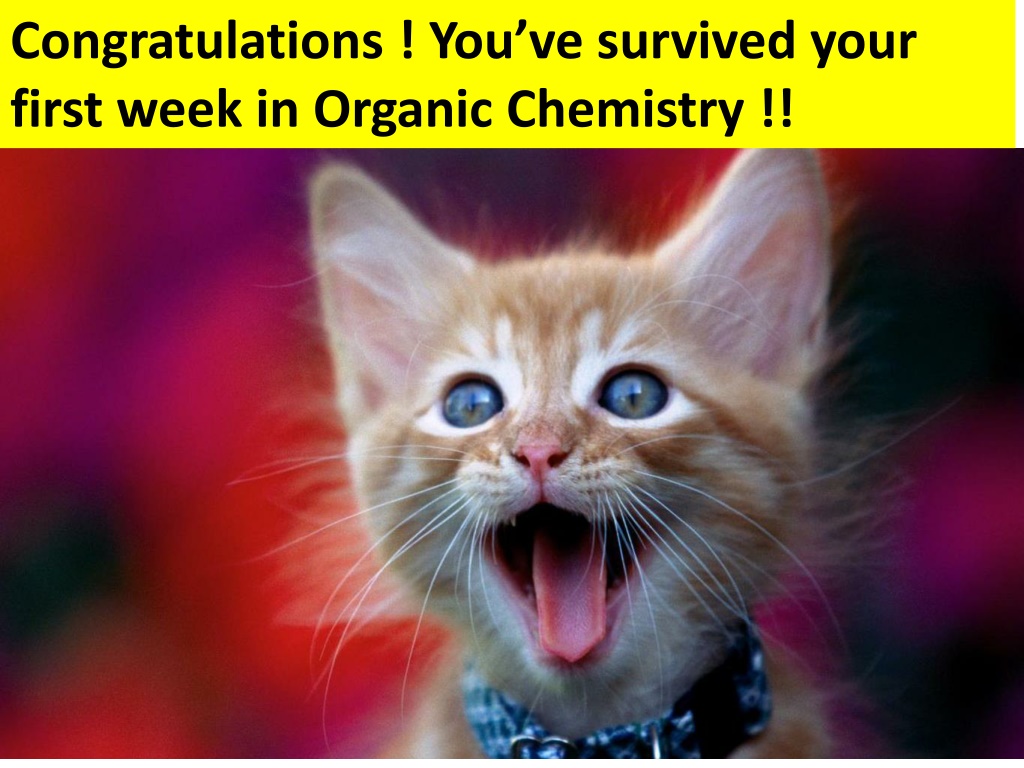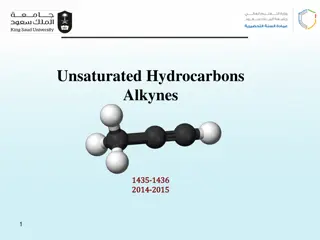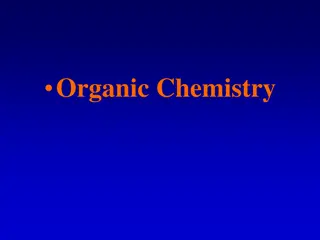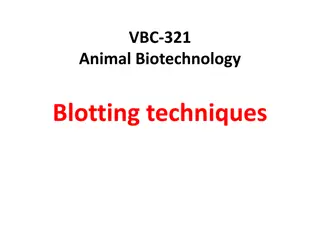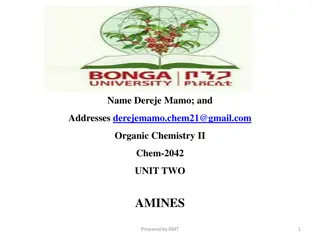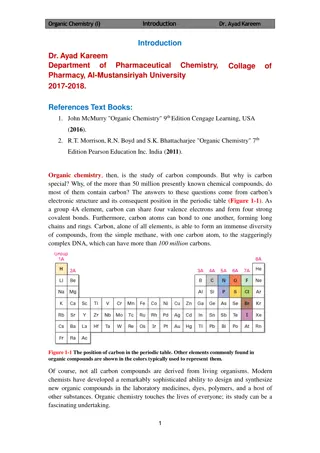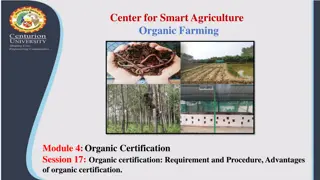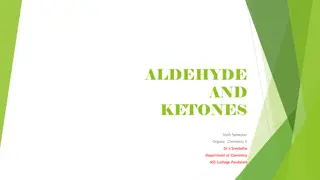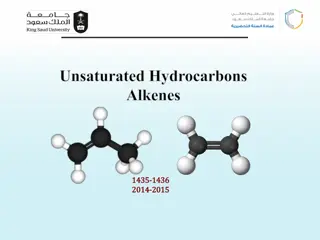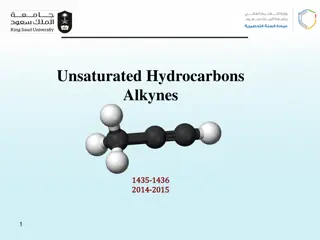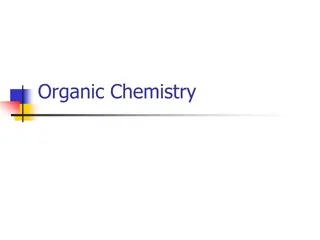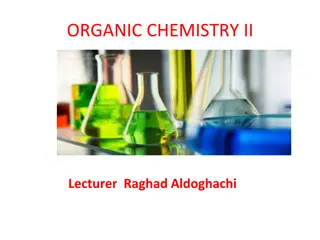Understanding Hybridization in Organic Chemistry
Delve into the complexities of the Lewis octet model and the insights provided by Linus Pauling's localized valence bond hybridization model to explain bond shapes in molecules, reactivity trends, and electron distribution in double and triple bonds. Discover how hybridization transforms atomic orbitals to create stable molecular bonds in organic compounds.
Download Presentation

Please find below an Image/Link to download the presentation.
The content on the website is provided AS IS for your information and personal use only. It may not be sold, licensed, or shared on other websites without obtaining consent from the author. Download presentation by click this link. If you encounter any issues during the download, it is possible that the publisher has removed the file from their server.
E N D
Presentation Transcript
Congratulations ! Youve survived your first week in Organic Chemistry !!
ISSUES WITH THE LEWIS OCTET MODEL (the nitpicking starts ) 1. How come the bond shapes in molecules look so little like the original atomic orbitals ???? 2. How does octet model account for the observed reactivity trend of ethane vs. ethene vs ethyne with halogens and ozone ? 3. How can you get all those electrons between carbons in double and triple bonds ? Don t they repel ?
Eventually, another All- American Superer Duperer Chemistry Star swoops in and fixes everything (for a while) http://izquotes.com/quotes-pictures/quote-facts-are-the-air-of-scientists-without-them-you-can-never-fly-linus-pauling-143007.jpg
Pauling goes back to the Chemists drawing board . s p 1 d 2 3 4 5 6 7 f
Paulings `Localized Valence Bond Hybridization Model PAULING S INSIGHTS Lewis isn t `wrong .he just hasn t : a) considered the role the valence s, p, d orbitals play b) realized that all bonds are not the same.
Linus Pauling fixes every criticism with Valence Bond or Atomic Orbital Hybridization model a) Atomic orbitals (AO) `reorganize as they approach each other b) s + np = spn n+1 equal hybrid molecular bonding lobes (# AO combined = # molecular `bonding lobes ) Sweet !! c) Bonding Lobes overlap between atoms to form bonds (2 e- /bond) d) Hybrid bonds more stable than unhybridized alternatives (`variational principle of quantum chemistry diversity breeds stronger bonds )
Hybridization is like using a blender s+ px +py AO in sp2 smoothy out Quantum Math Blender
Images of hybrid sigma bond formation #AO = number of identical lobes in LCAO Atomic orbitals (AO) Linearly Combined Atomic Orbitals (LCAO) linear sp 2s 2py trigonal plane pyramid 2s 2py 2px sp2 + + + sp3 2s 2py 2px 2pz
Anote about ` lobes: A lobe can contain either a bond or a lone pair CH4 = 4 C-H bonds => 4 lobes => s+ px + py + pz = sp3 NH3 = H | :N-H | H = 3 bonds + 1 lone pair => 4 lobes => s+ px + py + pz = sp3
Visualizing Hybridization: AO LCAO bond s and p AO on isolated C 1) Isolated AO on atoms approach each other from afar . 2) Isolated AO disappear and are re-formed into equal LCAO lobes as each atom `sees the other LCAO re-formed from AO on separate atoms 3c) un-overlapped lobes can bond to something else Un-overlapped lobe Sigma bond Un-overlapped lobe 3a) Two atoms get closer 3b) 2 LCAO near each other overlap reform into a `sigma bond. s and p AO on isolated C
Pi bonds: Paulings really great idea to use the `leftovers (extra bananas) Equivalent Pauling `sigma ( ) hybrid structure Ethene (C2H4) Lewis picture H H H H C C sp2 C C sp2 1 leftover pz on each C H H H H s+ px + py s+ px + py z x y
Pi bonds: Paulings really great idea to use the `leftovers (cont.) Equivalent Pauling `sigma ( ) hybrid structure Ethyne (C2H2) Lewis picture H C C H H C C H sp sp 2 leftover pz on each C s+ px s+ px z Z x x y y
USING THE PAULING MODEL: IN CLASS EXERCISE 2
How Paulings model `fixes the problems with Lewis model Atomic orbitals (AO) `reorganize (hybridize) when individual atoms approach each other such that the number of `links predicted by the Lewis model = the number of s, p (and d and f) orbitals combined in the reorganization. The `hybrid combinations are called Linear Combinations of Atomic Orbitals (LCAO). The `lobes in LCAO on individual atoms overlap and share two electrons between the atoms in a `sigma bond (often called a `valence or structural linkage bond.)
How Paulings model `fixes the problems with Lewis model (continued) 2. How does octet model account for the observed reactivity trend of ethane vs ethene vs ethyne with halogens and ozone ? `pi bonds are far less stable and far more reactive than sigma bonds. (Further out, softer, not between atoms but above and below) Ethane is held together by just `sigma bonds and is thus not very reactive. Both ethylene and acetylene have pi bonds which are easily reacted. That acetylene is more reactive than ethylene results because it has two pi bonds while ethylene has only 1 pi bond
How Paulings model `fixes the problems with Lewis model (continued) 3. How come ethene sticks to Pt, Rh and Ni in catalysis, but ethane doesn t ??? The large and loose electronic clouds above the metals are `soft and easily `blended (overlapped with like electronic distributions (e.g. soft and fluid). Pi bonds are soft and fluid; sigma bonds aren t. Moreover, the pi bonds are far away from the central core of the molecule, thus reducing nuclear-nuclear repulsions.
How Paulings model `fixes the problems with Lewis model (continued) The pi bonds occupy space above and below the sigma bond and thus do not crowd them. The two pi bonds are also on different and perpendicularly aligned planes to minimize pi-pi crowding.
Linus Pauling An American Chemical Genius I am awesome ( and kinda cute in a geeky way ) one of the heroes of my chemical youth I PAULING
Keen intuition + mathematical rigor + outside the box thinking + he s was a really nice guy and an inspired teacher ! FYI: You are all the great grandchildren of Linus Pauling !!!
http://pages.pomona.edu/~wes04747/chem164/MolZoo/EBW.jpg E. Bright Wilson Harvard University, Chemistry National Medal of Science 1975 T.W. Richards Endowed Chair Linus Pauling Cal Tech, Chemistry Nobel Prize in Chemistry 1954 Nobel Peace Prize 1962
http://academictree.org/photo/cache.068119.jpg YOU ! Doc Fong Senior Chemist SUNY Alfred State Chemistry (and nut case) R. L. Kuczkowski University of Michigan, Chemistry Department Chair
